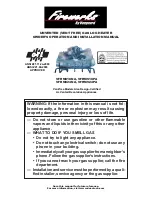
8
PROBLEM
CAUSE
SOLUTIONS
There is no spark
- appliance spark wire is disconnected
- piezoelectric mechanism broken
- the electrode is damaged
- reconnect
- test, replace
- replace
The pilot does not switch on when there is
a spark
- pilot injector blocked
- electrode activation position needs chan-
ging
- no gas supply
- air in the gas tubes
- clean by immersing in solvent or replace
- adjust
- open the appliance gas isolation valve
- purge air by turning on all gas rings on hob
for 30 seconds
The pilot does not stay on
- thermocouple faulty
- broken magnetic valve
- flue sensor faulty or activated
- replace
- replace
- check flueing/ventilation
- replace
Pilot on but the main burner does not ignite - insufficient water pressure
- the diaphragm is broken
- Increase the external water supply pressure
- rotate the knob B counter clockwise
- replace
The burner does not switch off when the
water turns off
- contamination on the gas valve seat
- gas valve push rod is locked in the open
position
- check the gas pressure
- test, clean
- Check the correct operation of the cold
water push rod , dis-assemble, clean or
replace
- if the inlet gas pressure exceeds the specifi-
cation replace the pressure regulator on
the external bottle or tank
Delayed burner activation
- pilot burner flame is too far from main
burner flame or it is too short
- check inlet gas pressure, clean injector and
pilot burner
The heat exchanger fins becomes sooty in a
small amount of time
- poor draught, adverse weather conditions
or dusty surroundings
- yellow flame
- excess gas consumption
- check the flue installation
- check the gas type and clean the burner
- check gas pressure and adjust
- Turn appliance water temperature selector fully anticlockwise
- Disconnect the cold water inlet to the water heater
- Full details of winterisation can be found under “troubleshooting” at
www.morcoproducts.co.uk
- A summary can be found on page 9 of this manual.
To use the appliance again reverse the above procedure
MAINTENANCE
To maintain the machine at maximum efficiency, have a Gas Safe Engineer
or other qualified personnel perform a maintenance check at least once
a year.
Before cleaning or performing maintenance, opening or disassembling the
panels, switch off the device and turn off the gas supply. Check the main
burner and the pilot flame, the ignition electrode, the safety valve and that
there is no gas or water leakage. Check that there is nothing obstructing
the passages within the heat exchanger or flue
To clean the outside of the panels utilize a cloth with soap and water.
Do not use solvents, powders or abrasive sponges.
Do not clean the device and/or its parts with flammable materials (e.g.
petrol, alcohol, diesel etc.).
Removing the casing
To remove the outer casing follow the steps below:
- Remove the selector knobs (C and D fig. 5 page 35)
- Remove the screws (E fig. 5 page 35)
- Pull the bottom of the casing forwards until clear of the gas/water
spindles
- Shift the casing upwards to free it from the upper and lateral hooks
- Shift the casing forwards
- To reinsert the casing, follow the above steps in reverse order
TROUBLESHOOTING: PROBLEMS
AND SOLUTIONS
For the best functioning of the water heater, to prolong its lifetime and
ensure that it is always safe, it should be inspected at least once a year
by a Gas safe engineer.
The Gas safe engineer is to perform the following maintenance opera-
tions:
- Remove any rust from the burner
- Remove any deposit from the electrodes
- Clean the combustion chamber
- Check the ignition, switching off and general functionality of the device
- Check that the gas and water pipes and connections are sealed
Warning: the flowing repair instructions are only to be performed by Gas
Safe Engineers or other qualified and authorized technicians.









































